Related Research Articles

Bruce Nauman is an American artist. His practice spans a broad range of media including sculpture, photography, neon, video, drawing, printmaking, and performance. Nauman lives near Galisteo, New Mexico.
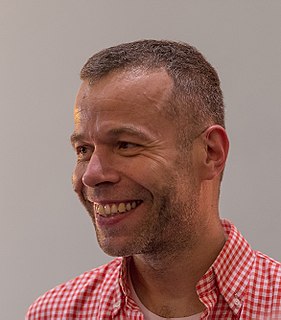
Wolfgang Tillmans is a German photographer. His diverse body of work is distinguished by observation of his surroundings and an ongoing investigation of the photographic medium’s foundations.
Marc Quinn is a British contemporary visual artist whose work includes sculpture, installation, and painting. Quinn explores "what it is to be human in the world today" through subjects including the body, genetics, identity, environment, and the media. His work has used materials that vary widely, from blood, bread and flowers, to marble and stainless steel. Quinn has been the subject of solo exhibitions at Sir John Soane's Museum, the Tate Gallery, National Portrait Gallery, Fondation Beyeler, Fondazione Prada and South London Gallery. The artist was a notable member of the Young British Artists movement.

Michel Majerus was a Luxembourgish artist who combined painting with digital media in his work. He lived and worked in Berlin until his untimely death in a plane crash in November 2002.

Christoph Maria Schlingensief was a German theatre director, performance artist, and filmmaker. Starting as an independent underground filmmaker, Schlingensief later staged productions for theatres and festivals, often accompanied by public controversies. In the final years before his death, he staged Parsifal at the Bayreuth Festival and worked at several opera houses, establishing himself as a Regietheater artist.

Dirk Skreber, is a contemporary artist who lives and works in New York City, New York, United States. He studied at the Kunstakademie Düsseldorf.

The Lenbachhaus is a building housing an art museum in Munich's Kunstareal.
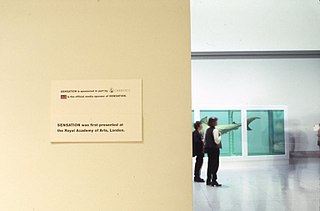
Sensation was an exhibition of the collection of contemporary art owned by Charles Saatchi, including many works by Young British Artists, (YBAs), which first took place 18 September – 28 December 1997 at the Royal Academy of Arts in London. The exhibition later toured to the Hamburger Bahnhof in Berlin and the Brooklyn Museum in New York City. A proposed showing at the National Gallery of Australia was cancelled when the gallery's director decided the exhibition was "too close to the market."
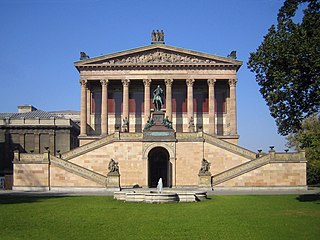
The Alte Nationalgalerie is a listed building on the Museum Island in the historic centre of Berlin and part of the UNESCO World Heritage. It was built from 1862 to 1876 by order of King Frederick William IV of Prussia according to plans by Friedrich August Stüler and Johann Heinrich Strack in Neoclassical and Renaissance Revival styles. The building's outside stair features a memorial to Frederick William IV. Currently, the Alte Nationalgalerie is home to paintings and sculptures of the 19th century and hosts a variety of tourist buses daily.

Hamburger Bahnhof is the former terminus of the Berlin–Hamburg Railway in Berlin, Germany, on Invalidenstrasse in the Moabit district opposite the Charité hospital. Today it serves as a contemporary art museum, the Museum für Gegenwart, part of the Berlin National Gallery.

Anthony McCall is a British-born New York based artist known for his ‘solid-light’ installations, a series that he began in 1973 with "Line Describing a Cone," in which a volumetric form composed of projected light slowly evolves in three-dimensional space.
Artists Anonymous are an art group based in Berlin and London. They were founded in 2001 during their studies at Berlin University of the Arts (UdK) at the classes of Georg Baselitz and Stan Douglas. They finished studying in 2006.

The Berlin State Museums are a group of institutions in Berlin, Germany, comprising seventeen museums in five clusters, several research institutes, libraries, and supporting facilities. They are overseen by the Prussian Cultural Heritage Foundation and funded by the German federal government in collaboration with Germany's federal states. The central complex on Museum Island was added to the UNESCO list of World Heritage Sites in 1999. By 2007, the Berlin State Museums had grown into the largest complex of museums in Europe. The museum was originally founded by King Friedrich Wilhelm III of Prussia in 1823 as the Königliche Museen.
Roman Signer is principally a visual artist who works in sculpture, art installations photography, and video.

David Tremlett is an English/Swiss sculptor, installation artist and photographer. He lives and works in Bovingdon, Hertfordshire, England. He is married to Laure Genillard who runs an art space in London, they were married in 1987.
Friedrich Christian Flick, also known as Mick Flick, is a German-Swiss art collector.
James Angus is an Australian artist known for 'his engaging and rigorously crafted sculptures'.
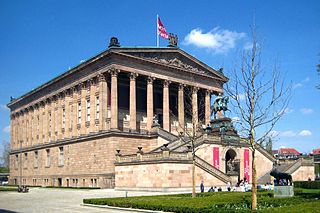
The National Gallery in Berlin, Germany, is a museum for art of the 19th, 20th and 21st centuries. It is part of the Berlin State Museums. From the Alte Nationalgalerie, which was built for it and opened in 1876, its exhibition space has expanded to include five other locations. The museums are part of the Berlin State Museums, owned by the Prussian Cultural Heritage Foundation.
Hugo Markl is a contemporary American artist, curator, and creative director. He studied Visual communication at the University of Applied Arts Vienna (1985–90) where he graduated with an M.A. in fine arts. His practice spans a broad range of media including sculpture, photography, video, drawing, printmaking, installation art, and performance. Markl lives in New York City.
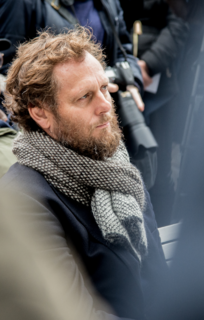
Olaf Nicolai is a German conceptual artist.
References
- ↑ "Top Collectors Don't Like to Discuss Their Families' Nazi Ties. Now, Artists Are Forcing Them to Confront the Past". Artnet News. 2021-04-30. Archived from the original on 2021-05-03. Retrieved 2021-05-06.
- ↑ Thomas Ramge: Die Flicks. Eine deutsche Familiengeschichte um Geld, Macht und Politik. Campus-Verlag, Frankfurt am Main 2004, ISBN 3-593-37404-8.
- ↑ Pressemitteilung: Hamburger Bahnhof – Museum für Gegenwart erhält 166 Werke zeitgenössischer Kunst als Schenkung von Friedrich Christian Flick [ permanent dead link ], 16. Februar 2008
- ↑ Shirley Apthorp (September 22, 2004), Berlin Exhibits Flick Art Collection Amid Protests Bloomberg .
- ↑ Collections Hamburger Bahnhof, Berlin.
- ↑ Shirley Apthorp (September 22, 2004), Berlin Exhibits Flick Art Collection Amid Protests Bloomberg .
- ↑ Alan Riding (July 06, 2004), Collector's Dark Family Past Sharply Divides Berlin New York Times
- ↑ Kate Connolly (September 21, 2004), Playboy's paintings 'financed by blood money' The Daily Telegraph .
- ↑ Shirley Apthorp (September 22, 2004), Berlin Exhibits Flick Art Collection Amid Protests Bloomberg .